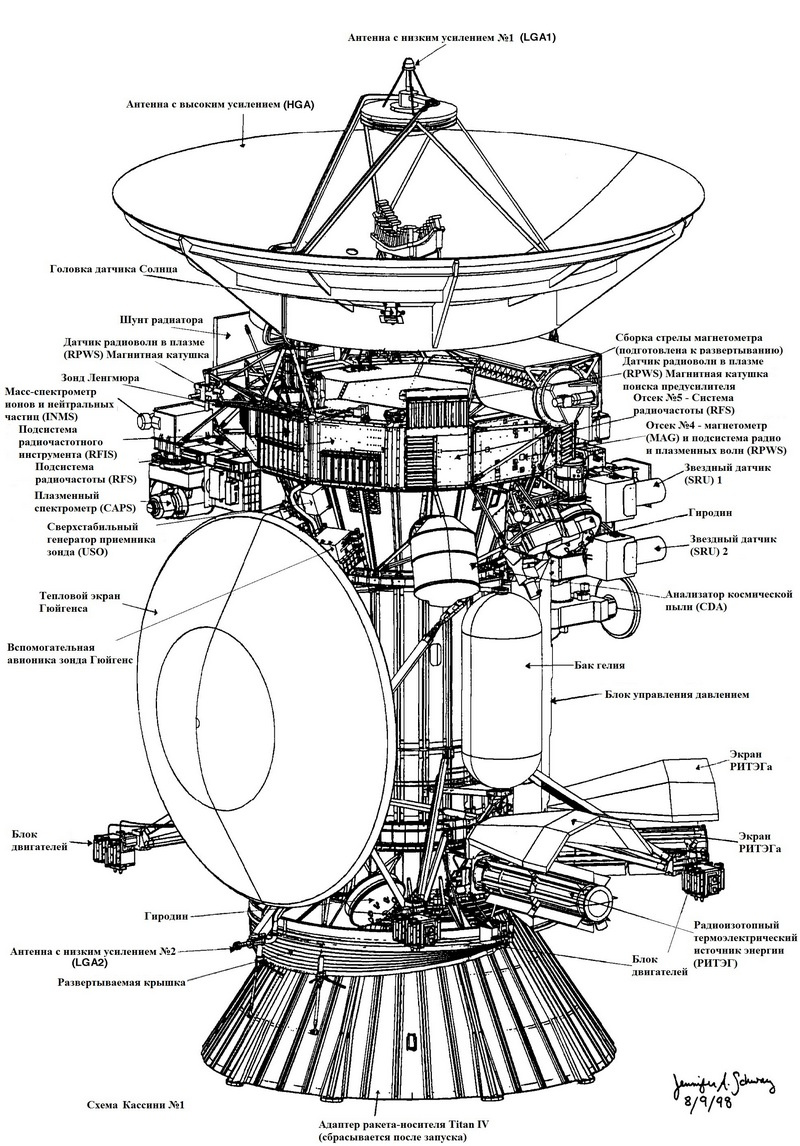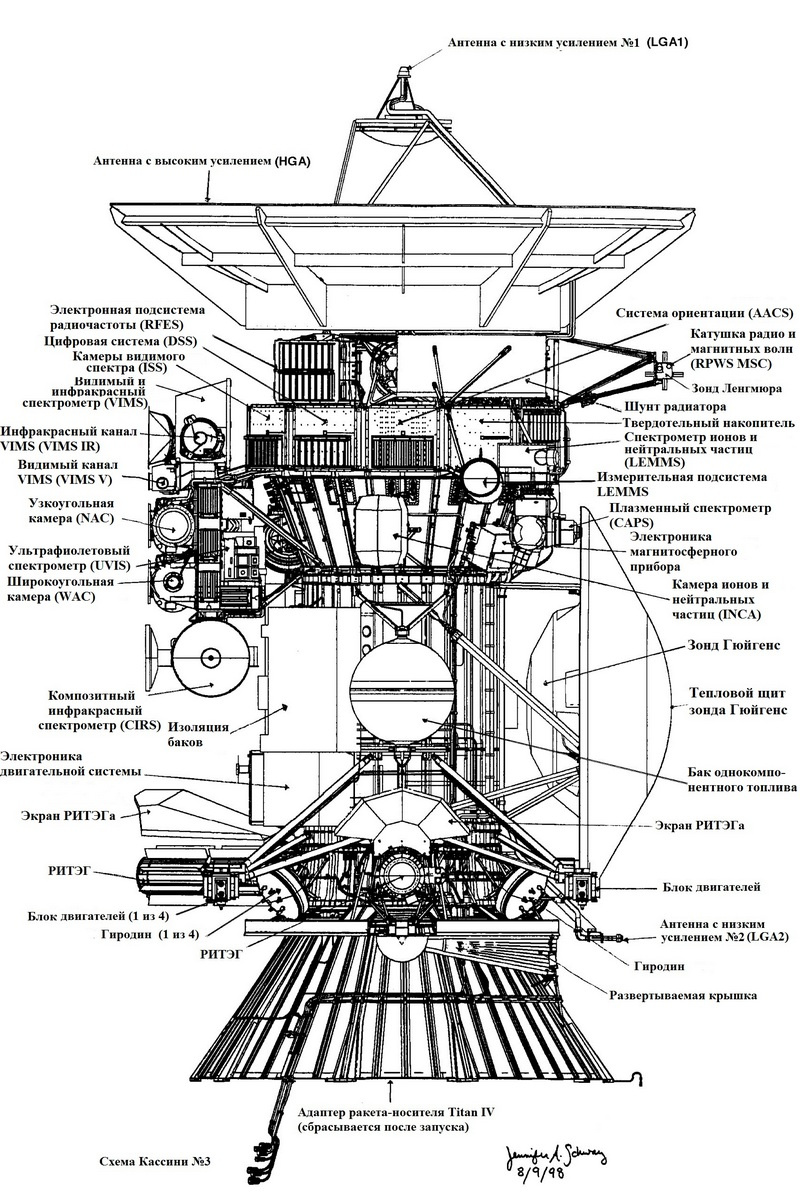Cassini-Huygens - Finale 20 years of research

September 15 at 14:54 Moscow time (11:54 UTC) is completed without one month Cassini’s 20-year mission — the orbital “half” of the automatic interplanetary station Cassini-Huygens an hour after landing on Titan). It was only the 4th mission to Saturn after Pioneer 11 and two Voyagers, and the only one in which the device went into its orbit. The next mission to the Saturn system should take place no earlier than 2029 .
During his mission, the device made 293 revolutions around Saturn, among which he made 162 passes near his satellites and discovered 7 new ones, transferred 453,048 photos of 635 GB of scientific data to Earth and became the source for 3,948 scientific publications. They discovered the ocean on Enceladus, as well as the ocean, 3 seas and hundreds of small lakes on Titan. About 5 thousand people from 27 countries participated in this project, and its total cost amounted to $ 3.9 billion in which the initial shares were distributed as: $ 2.6 billion from the US agency NASA, $ 500 million from the European ESA and $ 160 million from Italian ASI.
Cassini design
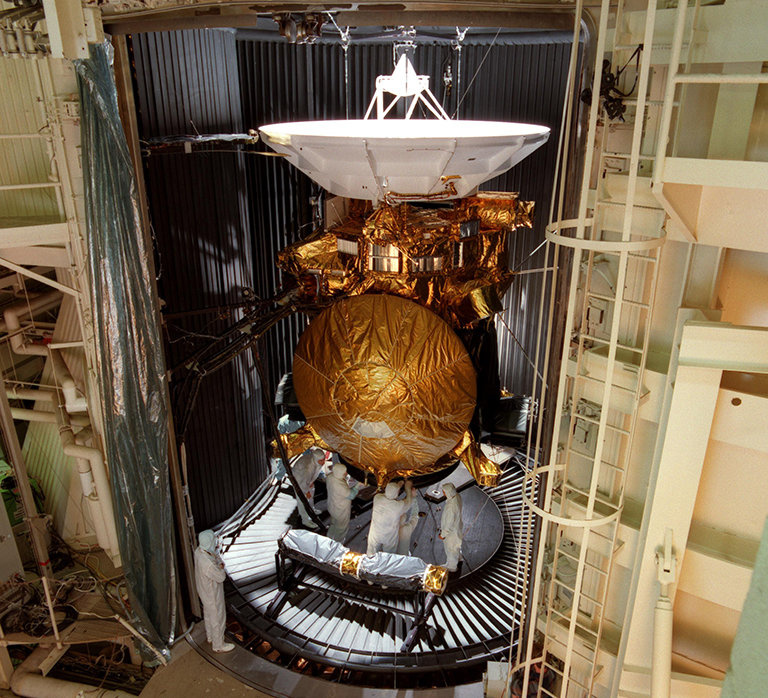
Apparatus Cassini-Huygens in the process of testing. The round orange part in the foreground - Huygens, who landed on Titan, the white part - 4-meter antenna / radar Cassini
The probe, named after Giovanno Cassini (who opened Saturn’s 2nd to 5th satellites), is as much as 6.8 meters high and 4 meters wide with a dry weight of 2150 kg (this was the third interplanetary probe after the mass of Soviet "Phobos" ). Saturn reaches only 1.1% of the solar energy available to us in Earth orbit, so the probe is powered by 3 RTGs of the same enormous size as the apparatus itself - they have 32.7 kg of plutonium-238 (this is 3.6 times more than both Voyagers at the start, 6.8 times more than Curiosity has and probably the most plutonium available by NASA at the moment: 1 , 2 ). The device has 1630 separate electronic components and 22 thousand wired connections with a total cable length of 14 km, and is controlled by duplicated 16-bit 1750A computers (another one controlled the Titan IV launch vehicle that put the device into orbit). Scientific equipment includes 12 instruments grouped into three groups, which are intended for 27 separate scientific studies:
Optical range sensors:
1) Composite infrared spectrometer, which includes cameras 3 ranges ( CIRS ); 2) wide-angle and narrow-angle (33 cm in diameter) cameras of the visible range with a set of several filters for different colors and CCD matrices with a resolution of 1024x1024 pixels. ( ISS ); 3) ultraviolet spectrometer, which includes 4 telescopes ( UVIS ); 4) the mapping spectrometer of the visible and infrared range, dividing the visible light into 352 spectral areas ( VIMS );
Sensors of magnetic fields and charged particles:
5) plasma spectrometer ( CAPS ); 6) cosmic dust analyzer fixing particles from microns to nanometers ( CDA ); 7) ion and neutral particle mass spectrometer ( INMS ); 8) a magnetometer, placed on an 11-meter dielectric boom, designed to reduce the influence of apparatus instruments on this sensor ( MAG ); 9) a tool for visualizing the magnetosphere, consisting of three ion and charged particle sensors located in different planes ( MIMI ); 10) a radio and plasma wave detector having three receivers of different frequencies ( RPWS );
Radio wave sensors:
11) 4-meter-in-diameter radar designed for the mapping of Saturn’s satellites ( Radar ); 12) scientific radio subsystem which consists in using the main 4-meter antenna for observing Saturn, its rings and satellites against the light by radio waves ( RSS ). The signal delay at Saturn is 68-84 minutes one way.
Note: the links are available 3D-models of each tool and the scheme of their position on the device.
Through thorns to Saturn
Infographics mission and video start 
A small note about Pakman - they got this name for the similarity of the thermal images of the planet with the main character of the game Pac-Man .

A small note about Pakman - they got this name for the similarity of the thermal images of the planet with the main character of the game Pac-Man .
The weight of the orbital and landing probes was too large for them to be directly launched to Saturn (from 350 kg of Huygens, the total weight of the device was 2.5 tons) - even taking into account the fact that the Titan IV on which Cassini-Huygens flew was 40% more useful load than the Titan IIIE on which the Voyagers flew. Therefore, the apparatus had to travel a lot around the Solar System, picking up speed with gravitational maneuvers to meet Saturn: after the launch on October 15, 1997, the 5.7 tons bundle of two vehicles filled with 2978 kg of fuel went to meet Venus. Having performed 2 gravitational maneuvers in her on April 26, 1998 and June 24, 1999 (in which they flew only 234 and 600 km from the planet, respectively), they returned briefly to Earth (flying 1171 km) on August 18, 1999 after which went already to Jupiter.

A photograph of the Moon made by a narrow-angle camera of the device in the near ultraviolet, from a distance of about 377 thousand km and an exposure of 80 μs.
Flying through the asteroid belt, the device met on January 23 with the Mazursky asteroid: unfortunately the distance was 1.6 million km, and the asteroid itself was only 15x20 km in size, so the photo was less than 10 by 10 pixels. On December 30, 2000, Cassini-Huygens met with Jupiter and his brother Galileo , whose mission was already approaching the final (he completed his mission almost 14 years ago with the same selfless feat that Cassini now intends to accomplish). This 4th gravitational maneuver finally gave the two vehicles sufficient speed to meet Saturn on July 1, 2004, by which time he had already traveled 3.4 billion kilometers.
In order not to waste time, the mission team used the device’s radio aerials to refine the Shapiro effect (slowing down the propagation of a radio signal as it moves in a gravitational field of a heavy object). The measurement accuracy was improved from previous results of 1/1000 in Vikings and Voyagers to 1/51000. Published on October 10, 2003, the results completely coincided with the predictions of the general theory of relativity.

The graph clearly shows the peaks of meetings with the planets (after which the apparatus increases speed), a long descent with a slight break in Jupiter (when the apparatus flew towards Saturn, gradually exchanging kinetic energy for potential, getting out of the "gravitational well" of the Sun), and a series waves at the end (when the unit went into orbit of Saturn, and began to rotate in its orbit).
Long-awaited meeting and main mission
On May 27, 2004, Cassini, for the first time since December 1998, turned on its main engine to give the device an impulse of 34.7 m / s, which was needed to correct the trajectory that held it on June 11, 2068 km from Phoebe , a very remote satellite of Saturn, which presumably formed in the Kuiper belt and was subsequently captured by the gravitational pull of Saturn. Because of the huge radius of the orbit of this satellite (averaging about 12.5 million km), this was the only meeting of Cassini with this satellite.
On July 1, the main engine of the device was switched on again (already at 96 minutes), in order to reset 626 m / s of speed to enter the orbit of Saturn. On the same day, Mefon was discovered and Pallene rediscovered, which was discovered on one of the Voyager-2 images, but since it was not on the other images, the orbit of the celestial body could not be established and for 25 years it received the designation S / 1981 S 14. The very next day, Cassini made the first flight past the Titan, on October 24, another satellite was opened ( Polidevk ), and on December 24 the landing probe Huygens was dropped.
On January 14, 2005, Cassini acted as a repeater for the landing probe (it will be discussed below), and the next day the device became as close as possible to Titan and, using its radar, discovered a 440-kilometer crater on its surface. On May 6, the Daphnis satellite was discovered, which lives on the edge of the Keeler slot:

At the edges of the 42-kilometer gap, waves were discovered caused by a very weak attraction of Daphnis (the weight of which is only 77 billion tons, which creates a gravity 25-100 thousand times lower than the earth's):

The equator of Saturn and the plane of its rings are inclined by 27 ° relative to the ecliptic, so that we can observe both poles of Saturn as well as observe its rings from the top and bottom. But since they are observed at a large angle and from huge distances (1.2-1.66 billion km depending on the relative position of the Earth and Saturn), it was simply impossible to see anything there, so let's say the Saturn hexagon was only detected flying past Voyagers.
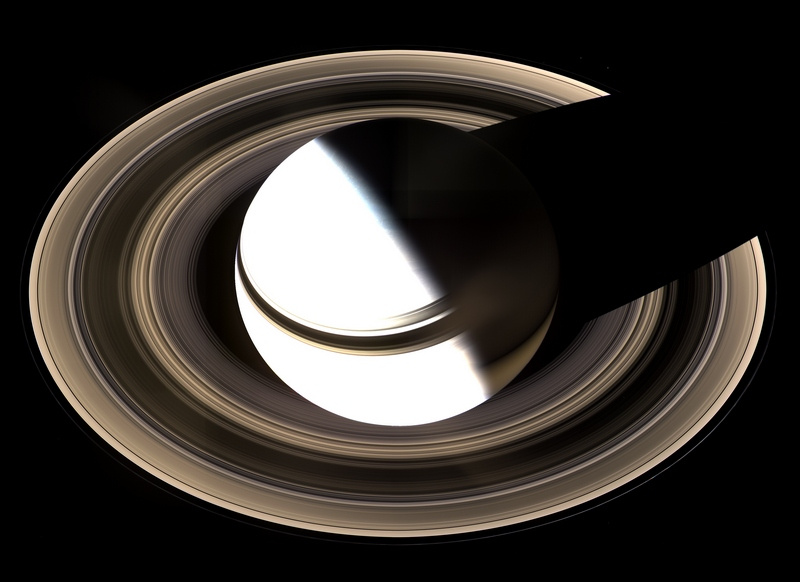
Photo of Saturn in natural colors, consisting of 36 Cassini images taken on January 19, 2007 with three filters (red, green and blue). The shutter speed of the pictures was made with the expectation of the dark areas of the rings, so the surface of Saturn turned out to be strongly overexposed.
In 2005, it was found that about 250 kg of water vapor at a speed of up to 600 m / s leave him every second through the geysers of Enceladus. In 2006, scientists were able to establish that they are the source of material for the penultimate and the widest - ring E.
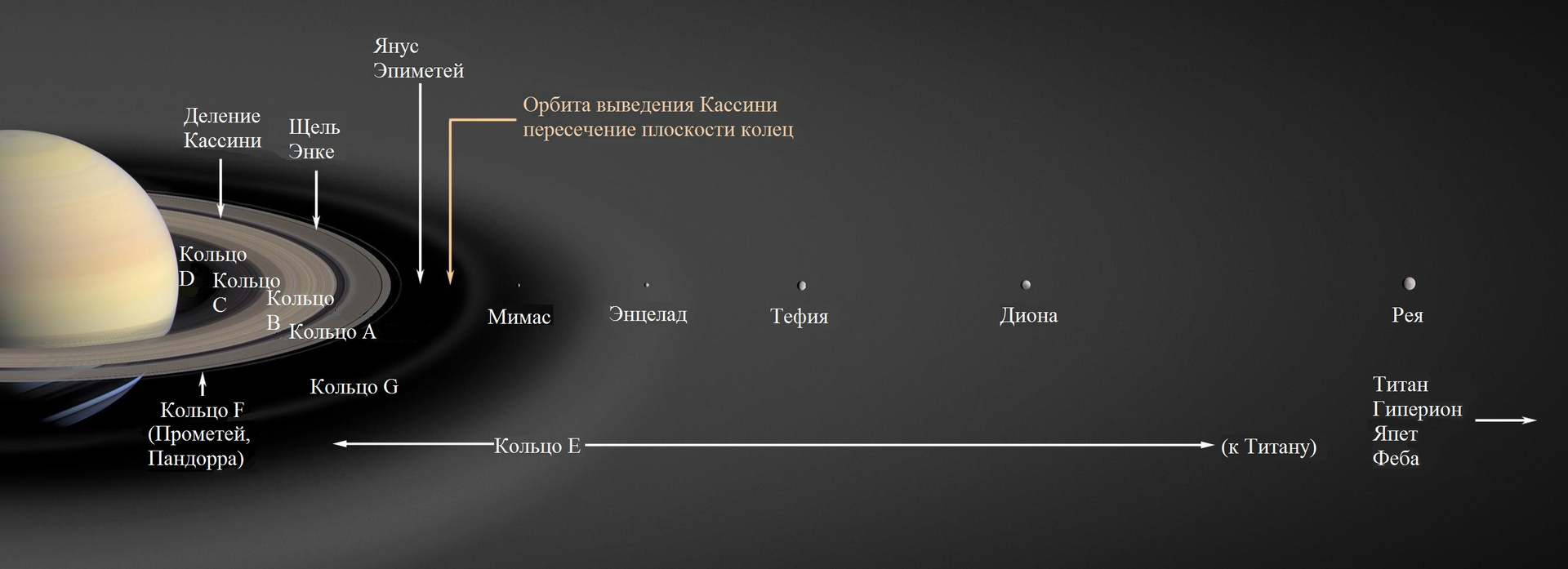
On July 22, 2006, the vehicle flew over the northern latitudes of Titan and for the first time dark areas were discovered on the radar map made by the vehicle, indicating that methane lakes are located on the surface in these places. During the 127 spans of the satellite, many areas of its surface were studied in detail, some of which showed dynamic changes. Among them was the Sea of Liegei , measuring 420x350 km and an average depth of about 50 m with a maximum of more than 200 m (the maximum depth recorded by the radar):

The most likely cause of such measurements are waves, solids under or above the surface or bubbles in the bulk of the liquid (which affect the reflectivity of the surface).
On May 30, 2007, the 2-kilometer satellite Anfa was discovered, and on September 10, the device passed only 1600 km from Yapet , but already when transmitting the images a particle of cosmic rays hit the computer, which caused its transition to safe mode. Fortunately, no pictures were lost. Shortly before this event, a video greeting of Arthur Clark on this event came (according to one of his most famous novels - “2001: A Space Odyssey” - on the surface of Yapet was one of the monoliths).
Video greeting and its translation
Hello! This is Arthur Clark joining you from my home in Colombo , Sri Lanka.
I am pleased to be part of this event on the Yapet spaceflight by the Cassini spacecraft.
I send my greeting to all friends - known and not known - who have gathered about this important event.
I am sorry that I cannot be with you, as I am wheelchair-bound by polio and do not plan to leave Sri Lanka again.
Thanks to the World Wide Web, I have been able to follow the Cassini-Huygens mission since its launch several years ago. As you know, I have something more than just an interest in Saturn.
And I was really scared in early 2005, when the Huygens probe transmitted sound recordings from the surface of Titan. This is exactly what I described in my 1975 novel Earth Empire, where my character listens to the wind blowing over the desert plains.
Perhaps it was the anticipation of the future! On September 10, if everything goes according to plan, Cassini will make our closest view of Iapet, one of Saturn’s most interesting satellites.
Half of Iapet is dark as asphalt, while the other half is light as snow. When Giovanni Cassini discovered Yapet in 1671, he could only see the bright side. We made our best glance when Voyager 2 flew past him in August 1981 - but it was almost a million kilometers away.
On the other hand, Cassini is going to pass in a little more than a thousand kilometers from Yapet.
This is a particularly exciting moment for fans of “2001: A Space Odyssey” - because the monolith of Saturn discovered by the lonely astronaut David Bowman became the gate to the stars.
The 35th chapter of the novel entitled “The Eye of Iapetus” contains the following fragment:
My God, it is full of companions!
However, in the film, Stanley Kubrick decided to put all the action into the system of Jupiter, not Saturn. Why such a change? Well, on the one hand, it made the plot more straightforward. And more importantly, the special effects department could not produce a Saturn model that Stanley would find convincing.
This was done correctly, because otherwise the film would have become outdated with the flight of the Voyager mission, which presented the rings of Saturn in a form that no one could even imagine.
I have seen many examples of Neptune being depicted in art, so I will keep my fingers crossed when Cassini flies past Yapet.
I want to thank everyone connected with the mission and the whole project. Perhaps he lacks the glamor of manned space flight, but a scientific project is extremely important for our understanding of the solar system. And who knows - maybe one day our survival on Earth will be dependent on what we find there.
This is Arthur Clark, I wish you a successful flight.
Hello! This is Arthur Clark joining you from my home in Colombo , Sri Lanka.
I am pleased to be part of this event on the Yapet spaceflight by the Cassini spacecraft.
I send my greeting to all friends - known and not known - who have gathered about this important event.
I am sorry that I cannot be with you, as I am wheelchair-bound by polio and do not plan to leave Sri Lanka again.
Thanks to the World Wide Web, I have been able to follow the Cassini-Huygens mission since its launch several years ago. As you know, I have something more than just an interest in Saturn.
And I was really scared in early 2005, when the Huygens probe transmitted sound recordings from the surface of Titan. This is exactly what I described in my 1975 novel Earth Empire, where my character listens to the wind blowing over the desert plains.
Perhaps it was the anticipation of the future! On September 10, if everything goes according to plan, Cassini will make our closest view of Iapet, one of Saturn’s most interesting satellites.
Half of Iapet is dark as asphalt, while the other half is light as snow. When Giovanni Cassini discovered Yapet in 1671, he could only see the bright side. We made our best glance when Voyager 2 flew past him in August 1981 - but it was almost a million kilometers away.
On the other hand, Cassini is going to pass in a little more than a thousand kilometers from Yapet.
This is a particularly exciting moment for fans of “2001: A Space Odyssey” - because the monolith of Saturn discovered by the lonely astronaut David Bowman became the gate to the stars.
The 35th chapter of the novel entitled “The Eye of Iapetus” contains the following fragment:
Discovery was approaching in Yapetu so slowly that the movement was almost not felt and it was impossible to notice that moment when an elusive change occurred and the cosmic body suddenly became a landscape some eighty kilometers below the ship. Reliable verniers gave the last corrective pushes and were silent forever. The ship went into its last orbit: the turnaround time is three hours, the speed is only one thousand three hundred kilometers per hour. Greater speed in this weak gravitational field was not required. Discovery became a satellite companion.More than 40 years later, I can not remember why I put the monolith of Saturn on Iapetus. At the time of the beginning of the Space Age, ground-based telescopes could not see the details of this celestial body. But I always had a strange fascination with Saturn and his family. By the way, this “family” grew at a very impressive pace: when Cassini was launched, we knew only about 18 of them. I understand that there are 60 of them now, and their number continues to increase. I can not resist the temptation to say:
My God, it is full of companions!
However, in the film, Stanley Kubrick decided to put all the action into the system of Jupiter, not Saturn. Why such a change? Well, on the one hand, it made the plot more straightforward. And more importantly, the special effects department could not produce a Saturn model that Stanley would find convincing.
This was done correctly, because otherwise the film would have become outdated with the flight of the Voyager mission, which presented the rings of Saturn in a form that no one could even imagine.
I have seen many examples of Neptune being depicted in art, so I will keep my fingers crossed when Cassini flies past Yapet.
I want to thank everyone connected with the mission and the whole project. Perhaps he lacks the glamor of manned space flight, but a scientific project is extremely important for our understanding of the solar system. And who knows - maybe one day our survival on Earth will be dependent on what we find there.
This is Arthur Clark, I wish you a successful flight.
Map Yapet with a resolution of 400 m per pixel (original 5 MB):
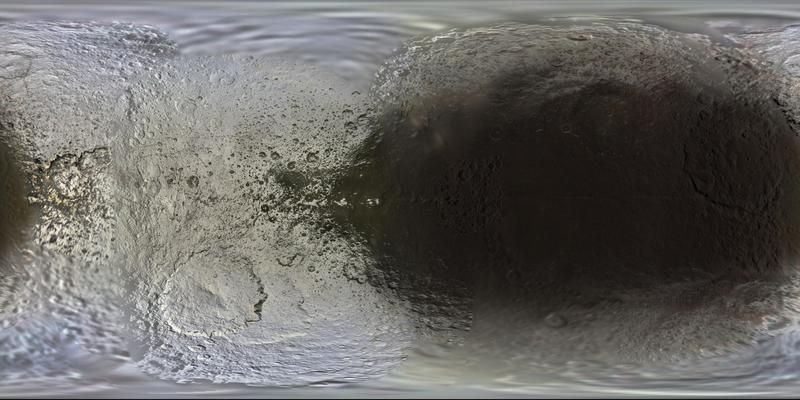
Approximately 40% of the surface of this satellite is occupied by dark areas with an albedo 10 times less than bright areas. Now the source of such a big difference is the effect of separation of dust and ice, when ice evaporates from dark areas and precipitates on light ones, thereby making light areas even brighter and darker ones darker. The reason that the other satellites behave "normally" is that they have a shorter day, during which the surface does not have enough time to warm up.
Extension and Cassini's Equinox Mission
On July 1, 2008, the expanded 27-month mission of Cassini began, which included 21 additional spans of Titan, 8 Tethys, 7 Enceladus, 6 Mimas and one span each of Dione, Ray and Elena.
On August 15, 2008, Egeon was discovered, although it was named after a monster with 100 hands and 50 heads, but it was an almost harmless “pebble” 500 meters in diameter (it was so small that it had to be set in terms of its brightness , so that we do not know the shape of this satellite). And on October 9, Cassini performed his most dangerous maneuver — a span just 25 km from Enceladus (and this is at a speed of 17.7 km / s!). The mission team took such a risky step for the sake of a direct analysis of the water vapor composition of its geysers.
In the course of its 23 flights, Enceladus for the entire time of the mission (in 10 of which the device approached a distance of less than 100 km), it was found that the pH of the subsurface ocean is 11-12 units (which is of little use for terrestrial life forms), but nitrogen (4 ± 1%), carbon dioxide (3.2 ± 0.6%), methane (1.6 ± 0.6%) and traces of ammonia, acetylene, hydrocyanic acid, and propane ( which indicates the active formation of organic substances under the surface of Enceladus). Unfortunately, the device does not contain special instruments for registering complex organics (since they couldn’t even guess about finding such an apparatus during mission planning), so the answer to the question “Is it possible for life to exist under the surface of Enceladus?” Cassini left for his followers.
By July 26, 2009, the last of Cassini’s discovered satellites was discovered - the 300-meter S / 2009 S 1 , which was discovered due to the 36-kilometer-long shadow that it casts on the far edge of ring B along which its orbit lies:

Second Extension and Cassini Solstice Mission
In February 2010, it was decided to further extend the mission, which began as early as September, and should have lasted until May 2017, when the final fate of the apparatus was to be decided. It included 54 more flights of Titan and 11 flights of Enceladus.
The efforts of Cassini and his team who managed to achieve an additional allocation of about $ 400 million for the next 7 years of the mission (bringing the cost of the program to almost $ 4 billion) were not in vain: in December 2010, during the flight of Enceladus, the device determined that it had an ocean under the North Pole (it was later established that the ocean is not limited to the polar region). In the same year, the Great White Spot reappeared on the surface of Saturn - a huge storm that appears in the atmosphere of Saturn approximately every 30 years (Cassini was very lucky with this, and he managed to register such storms twice - in 2006 and 2010). On October 25, 2012, the device recorded a powerful discharge inside it, which raised the temperature of the stratospheric layers of the atmosphere 83 ° C above normal. Thus, this vortex became the hottest among the storms in the solar system, beating even the Great Red Spot of Jupiter.
“The day when the Earth smiled” - a project organized on July 19, 2013 by the head of the visualization team Cassini, during which Cassini took a picture of the entire system of Saturn which also included the Earth, the Moon, Venus and Mars. A total of 323 photographs were taken, of which 141 were further used to create the mosaic:
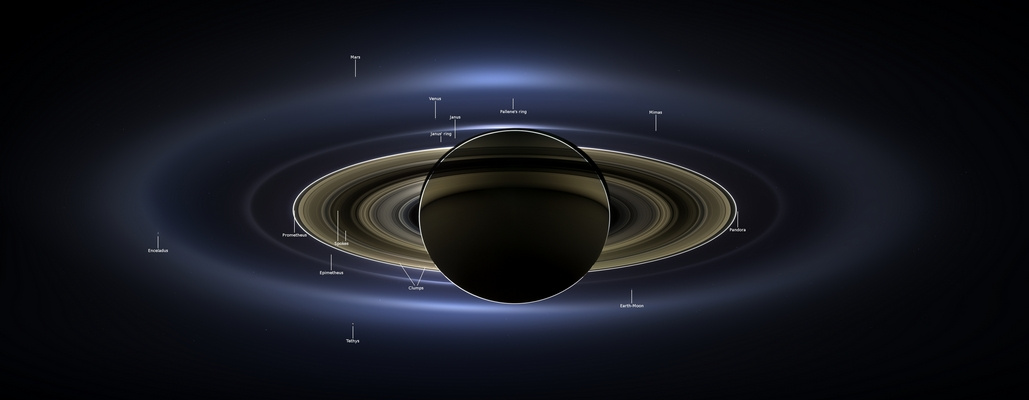
The land is in the lower right corner, and the original without signatures is here (4.77 MB).
Parallel to this, NASA launched the campaign “Pomashi Saturn” during which 1600 photographs were collected, of which a mosaic was collected on November 12, which was published on the cover of the New York Times on the same day (carefully, the original weighs 25.6 MB):
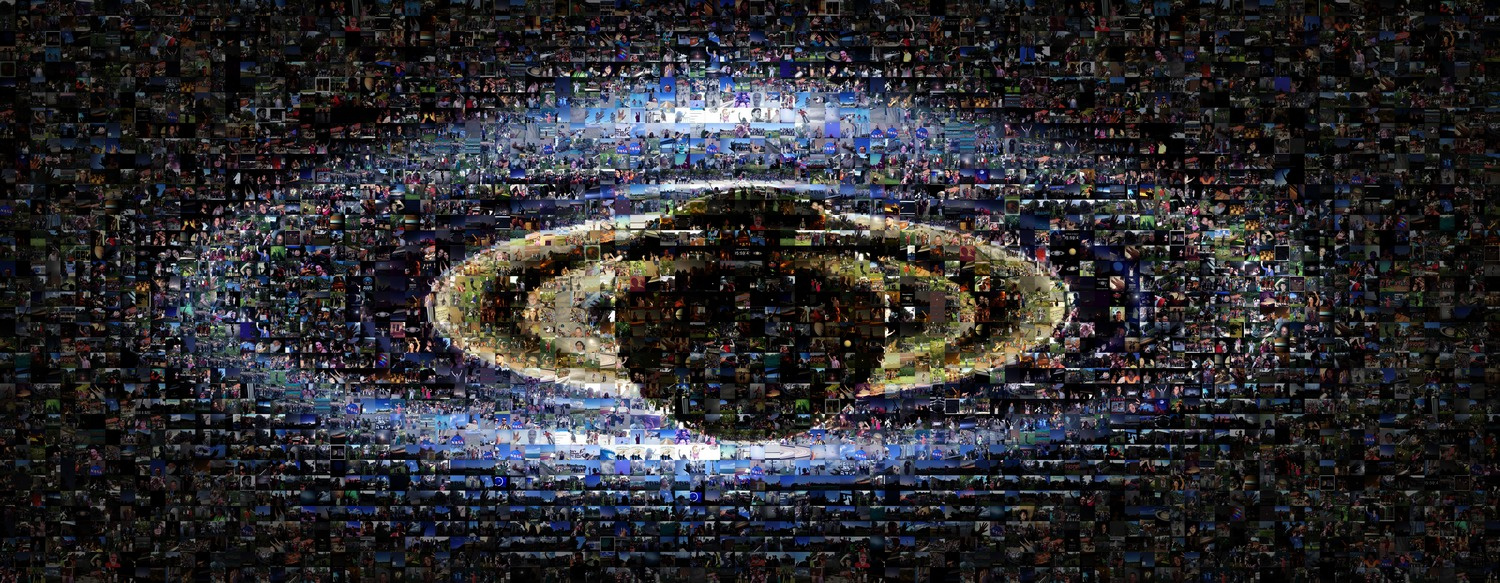
From 2012 to 2016, the device recorded changes in the color of the Saturn hexagon (photo from 2013 and 2017, the original 6 MB):

"Huygens"
The landing probe, named in honor of Christian Huygens (who opened the Titan in 1655, on which the probe landed), is a 318-kilogram apparatus with a diameter of 2.7 meters with 6 sets of tools:
1) constant frequency transmitter designed to measure wind speed by the Doppler effect (Doppler Wind Experiment - DWE);
2) sensors of the physical properties of the atmosphere measuring the density, pressure and electrical resistance of the atmosphere, as well as acceleration sensors along all three axes, which, together with the previous device, allow the determination of the density of the atmosphere (Huygens Atmospheric Structure Instrument - HASI);
3) cameras of the visible and infrared spectra, in parallel with obtaining images involved in measuring the spectrum and illumination at the current height of the device (Descent Imager / Spectral Radiometer - DISR);
4) aerosol particles pyrolyzer performing heating of samples taken from two different heights, and redirected them to the next device (Aerosol Collector and Pyrolyser - ACP);
5) gas chromatography-mass spectrometer measuring the composition and concentration of individual components of the atmosphere of Titan, and at the last stage also the evaporated top layer of soil (Gas Chromatograph Mass Spectrometer - GCMS);
6) a set of instruments for measuring surface properties, which include an acoustic sensor measuring the density / temperature of the atmosphere on the last 100 m of descent according to the properties of a sound reflected by a surface (Surface-Science Package - SSP).
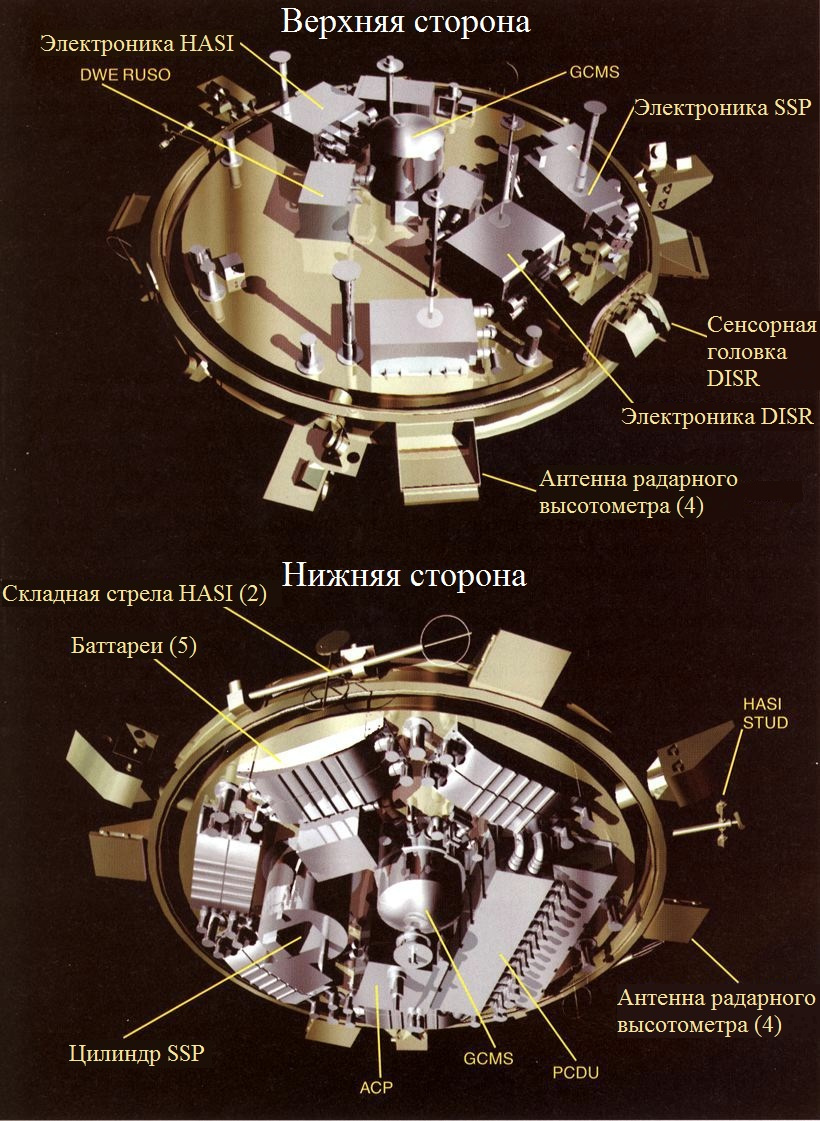
Huygens separated from Cassini on December 24, 2004, and by January 14 reached the atmosphere of Titan. The descent in the atmosphere took 2 hours and 27 minutes, during which the thermal protection of the device and its three parachutes successively took effect, and after landing it transmitted data from the surface for another 72 minutes (until the Cassini probe, which served as a signal repeater, went beyond the horizon).

Huygens probe international cooperation
Huygens top ten discoveries :
1) In the course of measuring the composition of the atmosphere from an altitude of 1,400 km to the surface itself, it was found that atmospheric layers above 500 km were warmer and denser than expected, and the average temperature here was -100 ° C with differences of 10-20 ° C, at an altitude of at 250 km, the temperature reached a maximum of -87 ° C (slightly above the minimum on Earth), and then dropped to -203 ° C at an altitude of 44 km. On the surface it was slightly warmer (-180 ° C) at a pressure of 1.47 atmospheres.
2) Western winds at an altitude of 120 km reached 430 km / h, at an altitude of 60 km, the device got into strong turbulence, after which the wind speed began to steadily decrease from 108 km / h to 55 km, to 36 km / h at an altitude of 30 km and 14 km / h for 20 km. At an altitude of 7 km, the wind direction changed and only a gentle breeze of 1-3.5 km / h acted on the probe. 165,8 .
3) , . , 40 , ≈5% 7 . . GCMS , , .
4) , -36 38, . , , -36/ , . , - .
5) 0,05% -40, ( 1,3 , ).
6) , , , ( ). , 80, 30 21 , 16 8 .
7) 130-35 25-20 . , . , 80 , 44 , 8 .
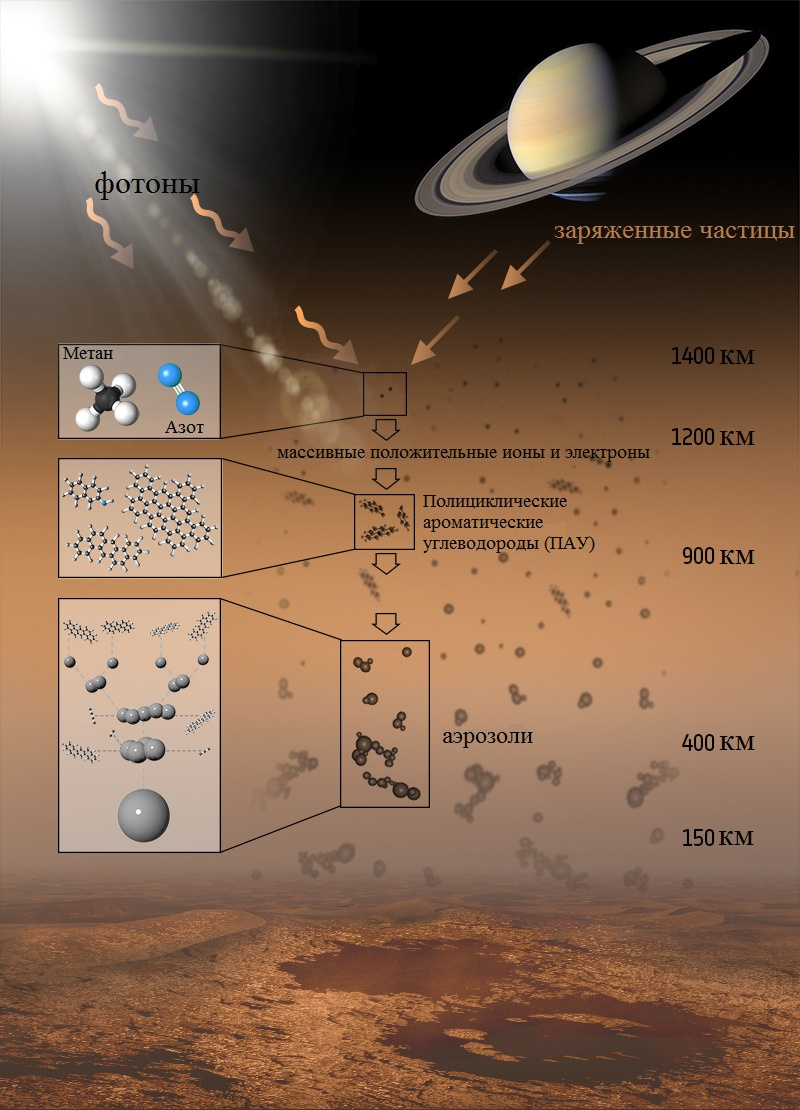
, , ( ). , , .
8) 700 , - — : , , , . , , ( ). , .
: , — , . - , - .
350 ( 3 ) : 100 , , . , 10-15 .
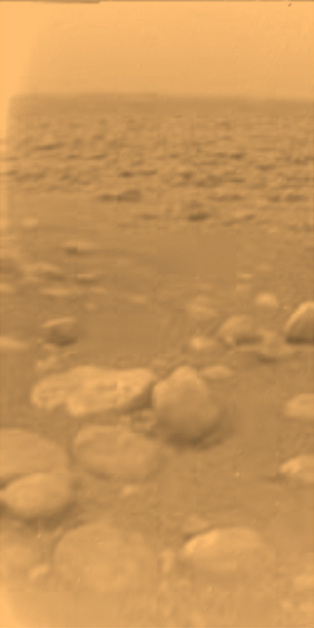
9) , . , . , 36 , , 140 40 60 . ( ), 55-80 .

, . VI — 81°C, - , , , ).
10) , 450 , , . « » , . «» , , .
/ 0,1-0,3 ( ), , — .
« »
2017 : , 19 , , , / ( ). , . 22 , 2000- .
21 1600-4000 , , 22- . , 4- , , . , — - , 1,4 .
References:
« »
3D-
(395 328 )
-10 ( 2011-2016)
-10 ( 2005-2016)
All Articles
